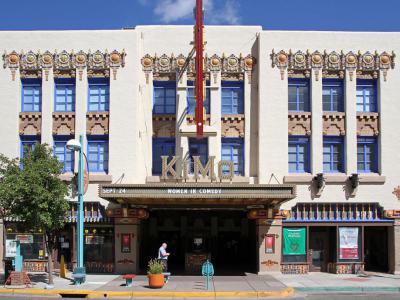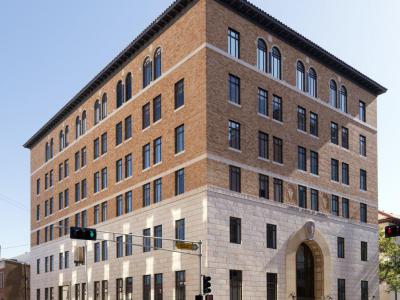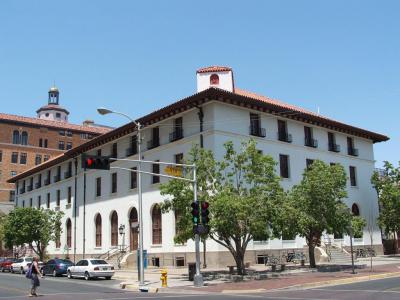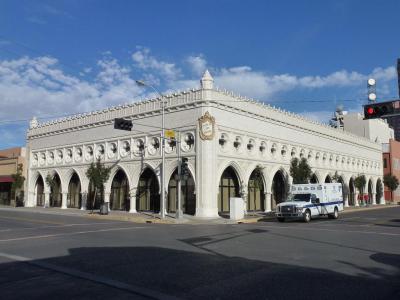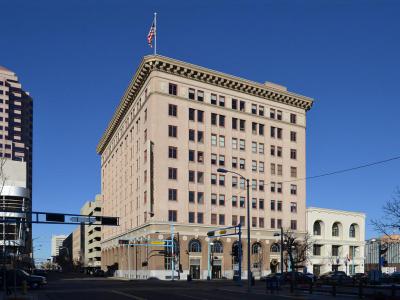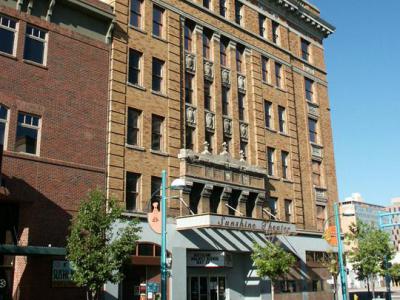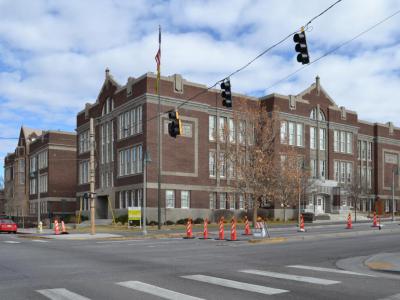
Downtown Historical Buildings Walking Tour (Self Guided), Albuquerque
The one-of-a-kind character of Albuquerque is the result of many different forces and centuries of history that have shaped the city. The core of Central Albuquerque is what most of the locals considered “downtown” – a place they lived, worked, shopped, governed and entertained themselves in for almost 80 years, since the arrival of the railroad in 1880.
The vibrant architectural tapestry of Downtown Albuquerque duly reflects the historical patterns of these activities, and is manifested in the variety of banks, hotels, federal and entertainment facilities, and more. Many of these buildings are listed on the State and National Register of Historic Places.
Kimo Theater – the extravagant landmark opened in 1927, whose name means "king of its kind". The Art Deco-Pueblo Revival Style architecture reflects motifs from the popular attractions of New Mexico's indigenous peoples and natural wonders.
The Old Post Office – built in 1908, is the oldest surviving federal building in Albuquerque, featuring Spanish Colonial Revival-style. Occidental Life Building – unique in the U.S., and one of Albuquerque's best-known and best-loved monuments. First National Bank Building – a historic nine-story edifice completed in 1923; the city's first skyscraper and tallest building until 1954.
Sunshine Building – a historic six-story property, one of Albuquerque's first skyscrapers; opened with much fanfare on May 1, 1924. Alvarado Transportation Center (Former Santa Fe Depot) – built in 1902, is a live reminder of the glory days of rail traffic through Albuquerque. Dignitaries such as Theodore Roosevelt and Clark Gable passed through it along with thousands of others en route to the West Coast.
If you wish to learn more about these and other well-known historic landmarks in Downtown Albuquerque, follow this self-guided walking tour.
The vibrant architectural tapestry of Downtown Albuquerque duly reflects the historical patterns of these activities, and is manifested in the variety of banks, hotels, federal and entertainment facilities, and more. Many of these buildings are listed on the State and National Register of Historic Places.
Kimo Theater – the extravagant landmark opened in 1927, whose name means "king of its kind". The Art Deco-Pueblo Revival Style architecture reflects motifs from the popular attractions of New Mexico's indigenous peoples and natural wonders.
The Old Post Office – built in 1908, is the oldest surviving federal building in Albuquerque, featuring Spanish Colonial Revival-style. Occidental Life Building – unique in the U.S., and one of Albuquerque's best-known and best-loved monuments. First National Bank Building – a historic nine-story edifice completed in 1923; the city's first skyscraper and tallest building until 1954.
Sunshine Building – a historic six-story property, one of Albuquerque's first skyscrapers; opened with much fanfare on May 1, 1924. Alvarado Transportation Center (Former Santa Fe Depot) – built in 1902, is a live reminder of the glory days of rail traffic through Albuquerque. Dignitaries such as Theodore Roosevelt and Clark Gable passed through it along with thousands of others en route to the West Coast.
If you wish to learn more about these and other well-known historic landmarks in Downtown Albuquerque, follow this self-guided walking tour.
How it works: Download the app "GPSmyCity: Walks in 1K+ Cities" from Apple App Store or Google Play Store to your mobile phone or tablet. The app turns your mobile device into a personal tour guide and its built-in GPS navigation functions guide you from one tour stop to next. The app works offline, so no data plan is needed when traveling abroad.
Downtown Historical Buildings Walking Tour Map
Guide Name: Downtown Historical Buildings Walking Tour
Guide Location: USA » Albuquerque (See other walking tours in Albuquerque)
Guide Type: Self-guided Walking Tour (Sightseeing)
# of Attractions: 9
Tour Duration: 1 Hour(s)
Travel Distance: 1.7 Km or 1.1 Miles
Author: doris
Sight(s) Featured in This Guide:
Guide Location: USA » Albuquerque (See other walking tours in Albuquerque)
Guide Type: Self-guided Walking Tour (Sightseeing)
# of Attractions: 9
Tour Duration: 1 Hour(s)
Travel Distance: 1.7 Km or 1.1 Miles
Author: doris
Sight(s) Featured in This Guide:
- Kimo Theater
- Federal Building and U.S. Courthouse
- Old Post Office of Albuquerque
- Occidental Life Building
- First National Bank Building
- Hotel Andaluz
- Sunshine Building
- Alvarado Transportation Center (Former Santa Fe Depot)
- Old Albuquerque High School
1) Kimo Theater
The KiMo Theater is probably the city's best-known landmark. It was built in 1927 in the extravagant Art Deco-Pueblo Revival Style architecture. The KiMo was conceived by entrepreneur Oreste Bachechi and designed for him by Carl Boller of the Boller Brothers architecture firm, who conducted an extensive investigation into the cultures and building styles of the Southwest before submitting his design.
The theater is a three-story stucco building with the stepped massing characteristic of native pueblo architecture, as well as the recessed spandrels and strong vertical thrust of Art Deco skyscrapers. Both the exterior and interior of the building incorporate a variety of indigenous motifs, like the row of terra cotta shields above the third-floor windows. The KiMo Theater is rumored to be haunted by the ghost of Bobby Darnall, a six-year old boy killed when a water heater in the theater's lobby exploded in 1951.
The theater is a three-story stucco building with the stepped massing characteristic of native pueblo architecture, as well as the recessed spandrels and strong vertical thrust of Art Deco skyscrapers. Both the exterior and interior of the building incorporate a variety of indigenous motifs, like the row of terra cotta shields above the third-floor windows. The KiMo Theater is rumored to be haunted by the ghost of Bobby Darnall, a six-year old boy killed when a water heater in the theater's lobby exploded in 1951.
2) Federal Building and U.S. Courthouse
Located in downtown Albuquerque, the Federal Building and United States Courthouse is a historic landmark that was constructed in 1930. Situated on Gold Avenue, it is part of a complex of federal buildings that include the Old Post Office, Dennis Chavez Federal Building, and the Federal Building.
This imposing six-story building features a facade made of limestone and buff-colored terra-cotta tile arranged in a brick pattern with molded inlays. It is crowned by a red tile roof in Mediterranean style and a domed cupola. The Office of the Supervising Architect under James A. Wetmore designed the building.
Inside the lobby of the Federal Building, visitors can find a mural titled The Rebellion of 1680 by Loren Mozley that depicts the Pueblo Revolt. On the sixth floor, outside the District Courtroom, Emil Bisttram's Justice Tempered with Mercy adorns the wall. This courtroom was historically significant and used by the U.S. District Court until 1965 when it relocated to the Dennis Chavez Building. The courtroom was restored to its original appearance in 1981.
In 1980, the Federal Building was added to the National Register of Historic Places.
This imposing six-story building features a facade made of limestone and buff-colored terra-cotta tile arranged in a brick pattern with molded inlays. It is crowned by a red tile roof in Mediterranean style and a domed cupola. The Office of the Supervising Architect under James A. Wetmore designed the building.
Inside the lobby of the Federal Building, visitors can find a mural titled The Rebellion of 1680 by Loren Mozley that depicts the Pueblo Revolt. On the sixth floor, outside the District Courtroom, Emil Bisttram's Justice Tempered with Mercy adorns the wall. This courtroom was historically significant and used by the U.S. District Court until 1965 when it relocated to the Dennis Chavez Building. The courtroom was restored to its original appearance in 1981.
In 1980, the Federal Building was added to the National Register of Historic Places.
3) Old Post Office of Albuquerque
In downtown Albuquerque, New Mexico, at the northwest corner of Fourth and Gold, stands the Old Post Office. This building, constructed in 1908 under the supervision of architect James Knox Taylor, is the oldest surviving federal building in Albuquerque. It is built in the Spanish Colonial Revival style and was originally home to several federal agencies. However, due to overcrowding, the construction of the Federal Building and the U.S. Courthouse next door was necessary in 1930. The post office continued to operate in the older building until 1972 when it was remodeled to become the Amy Biehl Charter High School.
In 1907, when Albuquerque reached the "first post office" class, plans for the new facility were announced, and construction began. The area's rapid growth quickly made the building inadequate to meet the needs of the Post Office, courts, and other tenants. An addition was built in 1932, and the larger Federal Building was constructed in 1930. The building has undergone numerous remodels and space changes to accommodate various tenants over the years.
The exterior of the original 1908 building and the 1932 addition are visible on the east, south, and west elevations. The north elevation of the 1908 building is visible as it fronts a parking area. While the building appears to be a single structure, there are clear indications of where the 1932 addition begins. Both period exteriors consist of a limestone base, a stucco finish painted brown up to the eaves, an exposed soffit with massive decorative rafter ends, and a red clay tile roof.
The Old Post Office is an important historic landmark and was added to the National Register of Historic Places in 1980. It is part of a complex of Albuquerque federal buildings, including the National Register-listed U.S. Courthouse, the former Federal Building on Gold Ave SW, and the Chavez Federal Building.
In 1907, when Albuquerque reached the "first post office" class, plans for the new facility were announced, and construction began. The area's rapid growth quickly made the building inadequate to meet the needs of the Post Office, courts, and other tenants. An addition was built in 1932, and the larger Federal Building was constructed in 1930. The building has undergone numerous remodels and space changes to accommodate various tenants over the years.
The exterior of the original 1908 building and the 1932 addition are visible on the east, south, and west elevations. The north elevation of the 1908 building is visible as it fronts a parking area. While the building appears to be a single structure, there are clear indications of where the 1932 addition begins. Both period exteriors consist of a limestone base, a stucco finish painted brown up to the eaves, an exposed soffit with massive decorative rafter ends, and a red clay tile roof.
The Old Post Office is an important historic landmark and was added to the National Register of Historic Places in 1980. It is part of a complex of Albuquerque federal buildings, including the National Register-listed U.S. Courthouse, the former Federal Building on Gold Ave SW, and the Chavez Federal Building.
4) Occidental Life Building
The Occidental Life Building, situated in Downtown Albuquerque, is a renowned office building that boasts a distinctive Venetian Gothic Revival architectural style. It is widely regarded as one of the most recognizable landmarks in the city, and its uniqueness has been acknowledged nationwide.
Designed by Henry C. Trost, the building was inaugurated in 1917 but was severely damaged by a fire in 1933. Despite this setback, the exterior walls remained intact, and the structure was subsequently rebuilt by W. Miles Brittelle, who took the opportunity to redesign the roofline to achieve a more consistent Venetian appearance. The building underwent further renovation in 1981, which included the addition of a second story to the interior.
The building's primary attraction is its white terra cotta facade, which enfolds the south and east sections of the edifice. The facade is patterned after the Doge's Palace in Venice and is distinguished by arcades of pointed Venetian Gothic arches, quatrefoil windows, and an ornamental frieze with a line of finials, added after the 1934 renovation. The spandrels and capitals are bedecked with intricate floral ornamentation, and the building's curved corners are punctuated with pointed turrets.
Positioned on the northwest corner of Third Street and Gold Avenue, the Occidental Life Building was recognized as a cultural property of the New Mexico State Register in 1973 and was listed on the National Register of Historic Places in 1978.
Designed by Henry C. Trost, the building was inaugurated in 1917 but was severely damaged by a fire in 1933. Despite this setback, the exterior walls remained intact, and the structure was subsequently rebuilt by W. Miles Brittelle, who took the opportunity to redesign the roofline to achieve a more consistent Venetian appearance. The building underwent further renovation in 1981, which included the addition of a second story to the interior.
The building's primary attraction is its white terra cotta facade, which enfolds the south and east sections of the edifice. The facade is patterned after the Doge's Palace in Venice and is distinguished by arcades of pointed Venetian Gothic arches, quatrefoil windows, and an ornamental frieze with a line of finials, added after the 1934 renovation. The spandrels and capitals are bedecked with intricate floral ornamentation, and the building's curved corners are punctuated with pointed turrets.
Positioned on the northwest corner of Third Street and Gold Avenue, the Occidental Life Building was recognized as a cultural property of the New Mexico State Register in 1973 and was listed on the National Register of Historic Places in 1978.
5) First National Bank Building
Located in downtown Albuquerque, the First National Bank Building was the former headquarters of the First National Bank of Albuquerque and is now a historic landmark. Constructed in 1922-23, it replaced an older building at Second and Gold Streets. The El Paso firm of Trost & Trost designed the building at the request of the bank, with Henry C. Trost as the lead architect. The nine-story building, standing at 141 feet (43 meters), was the tallest structure in Albuquerque and was dubbed the city's first skyscraper. It remained the tallest building in the city until 1954 when it was surpassed by the Simms Building.
After relocating to First Plaza in 1975, the First National Bank sold the building but regained ownership in 1990 and moved some of its departments back in. First Security Bank, the bank's successor, owned the building until 1999 when it was purchased by a private developer who intended to convert it into a luxury hotel. However, the plans changed, and the building was eventually remodeled into high-end condominiums known as The Banque Lofts, which opened in 2006.
Architecturally, the L-shaped First National Bank Building comprises three sections: a two-story base, a six-story main block, and a one-story crown. The base contains the original double-height banking hall, a mezzanine, and a row of 22-foot (6.7 meters) high arched windows extending around the building, including into the alley. The building is decorated with various ornaments, such as scrolls, rosettes, medallions, and moldings. The ninth floor boasts corner medallions and a heavy cornice, and a string course sets it apart from the rest of the building. The concrete-framed structure features a full basement and two mechanical floors. The banking lobby has a high coffered ceiling supported by two rows of octagonal columns and continues the arched window pattern on all four sides. The lobby area was renovated into office space in 2017 but it still retains most of its original details, including the bank vault.
In 1978, the First National Bank Building was added to the New Mexico State Register of Cultural Properties, and in 1979, it was listed on the National Register of Historic Places.
After relocating to First Plaza in 1975, the First National Bank sold the building but regained ownership in 1990 and moved some of its departments back in. First Security Bank, the bank's successor, owned the building until 1999 when it was purchased by a private developer who intended to convert it into a luxury hotel. However, the plans changed, and the building was eventually remodeled into high-end condominiums known as The Banque Lofts, which opened in 2006.
Architecturally, the L-shaped First National Bank Building comprises three sections: a two-story base, a six-story main block, and a one-story crown. The base contains the original double-height banking hall, a mezzanine, and a row of 22-foot (6.7 meters) high arched windows extending around the building, including into the alley. The building is decorated with various ornaments, such as scrolls, rosettes, medallions, and moldings. The ninth floor boasts corner medallions and a heavy cornice, and a string course sets it apart from the rest of the building. The concrete-framed structure features a full basement and two mechanical floors. The banking lobby has a high coffered ceiling supported by two rows of octagonal columns and continues the arched window pattern on all four sides. The lobby area was renovated into office space in 2017 but it still retains most of its original details, including the bank vault.
In 1978, the First National Bank Building was added to the New Mexico State Register of Cultural Properties, and in 1979, it was listed on the National Register of Historic Places.
6) Hotel Andaluz
Opened on June 9, 1939 as the Hilton Hotel, it was Conrad Hilton's fourth hotel and the first modern high-rise hotel in the state. Architect Anton F. Korn designed the 160-room ten-story building in the New Mexico Territorial style, with earthtone stucco, brick coping along the roofline, and southwest-style woodwork and furnishings. In 1969, after Hilton built a new hotel nearby, they sold the hotel and it became the Hotel Plaza. It was sold again in 1981 and closed.
The new owners planned to restore it as the Hotel Bradford, but the hotel sat vacant and never opened under that name. The hotel was finally renovated in 1984, with the number of rooms reduced to 114. It was placed on the National Register of Historic Places, and reopened on August 3, 1984 as La Posada de Albuquerque.
In 2005, the hotel was purchased by Gary Goodman, whose company Goodman Realty Group is also behind the upcoming Winrock Town Center. In March 2008, the hotel underwent an extensive $30 million renovation and restoration, reopening as Hotel Andaluz on October 1, 2009. The hotel was honored with LEED Gold certification for its sustainability, and has been recognized many times over the years by Conde Nast as one of the top hotels in the U.S. southwest.
The property features Más Tapas y Vino, a Spanish-influenced "dining experience" under the helm of Executive Chef Marc Quinones. It also offers the Ibiza Urban Rooftop Lounge and an extensive live entertainment program on weekends. 6,000 square feet (560 square meters) of conference facilities.
During 2019, the hotel was used as a location for scenes in the fifth series of the television drama Better Call Saul.
The new owners planned to restore it as the Hotel Bradford, but the hotel sat vacant and never opened under that name. The hotel was finally renovated in 1984, with the number of rooms reduced to 114. It was placed on the National Register of Historic Places, and reopened on August 3, 1984 as La Posada de Albuquerque.
In 2005, the hotel was purchased by Gary Goodman, whose company Goodman Realty Group is also behind the upcoming Winrock Town Center. In March 2008, the hotel underwent an extensive $30 million renovation and restoration, reopening as Hotel Andaluz on October 1, 2009. The hotel was honored with LEED Gold certification for its sustainability, and has been recognized many times over the years by Conde Nast as one of the top hotels in the U.S. southwest.
The property features Más Tapas y Vino, a Spanish-influenced "dining experience" under the helm of Executive Chef Marc Quinones. It also offers the Ibiza Urban Rooftop Lounge and an extensive live entertainment program on weekends. 6,000 square feet (560 square meters) of conference facilities.
During 2019, the hotel was used as a location for scenes in the fifth series of the television drama Better Call Saul.
7) Sunshine Building
The Sunshine Building, situated in downtown Albuquerque, is a six-story historical building constructed in 1924 by local theater owner Joseph Barnett. It houses commercial spaces and offices in addition to the Sunshine Theater. Initially, Sunshine operated mainly as a movie theater, with facilities for live performances such as Vaudeville and shows. Since 1990, the theater has been operating as a live music venue, featuring various famous artists. This building is a registered Cultural Property of New Mexico State since 1985 and is also a designated Albuquerque City Landmark.
Trost & Trost, an El Paso firm, designed the building with a facade of yellow brick and reinforced concrete construction. Its architectural style is Renaissance Revival, and the building was recognized for its manually operated elevator, which was believed to be the last in New Mexico. The building's exterior was used as the fictional office for the US Marshals' Witness Protection Service in the TV show, In Plain Sight.
The Sunshine Theater, which occupies a significant portion of the building, was initially a movie theater until the 1980s but was later remodeled as a popular live music venue. It has hosted numerous renowned artists such as The Strokes, Snoop Dogg, and The Smashing Pumpkins, among others. With an open floor, a large balcony, and a bar that accommodates an audience of 21 and older, the theater can hold up to 1,000 people. It is the most popular venue in the Albuquerque metropolitan area for smaller yet noteworthy acts, with several having five or more shows per month.
Trost & Trost, an El Paso firm, designed the building with a facade of yellow brick and reinforced concrete construction. Its architectural style is Renaissance Revival, and the building was recognized for its manually operated elevator, which was believed to be the last in New Mexico. The building's exterior was used as the fictional office for the US Marshals' Witness Protection Service in the TV show, In Plain Sight.
The Sunshine Theater, which occupies a significant portion of the building, was initially a movie theater until the 1980s but was later remodeled as a popular live music venue. It has hosted numerous renowned artists such as The Strokes, Snoop Dogg, and The Smashing Pumpkins, among others. With an open floor, a large balcony, and a bar that accommodates an audience of 21 and older, the theater can hold up to 1,000 people. It is the most popular venue in the Albuquerque metropolitan area for smaller yet noteworthy acts, with several having five or more shows per month.
8) Alvarado Transportation Center (Former Santa Fe Depot)
The Santa Fe Depot was a historic railroad station in Albuquerque which burned down in 1993. It was originally built by the Atchison, Topeka and Santa Fe Railway in 1902 along with the neighboring Alvarado Hotel. After the hotel was razed in 1970, the depot remained in use by ATSF and then Amtrak passenger trains. The building was listed on the New Mexico State Register of Cultural Properties in 1981 and was designated an Albuquerque Historic Landmark.
The Santa Fe Depot was built in 1902, replacing an earlier two-story wooden building. It was part of a larger complex that also included the Alvarado Hotel, an "Indian Building" where tourists could buy southwestern curios, and various outbuildings. The depot and hotel were designed by Charles Frederick Whittlesey and built by Anson & Holman at a total cost of about $80,000.
During the early 20th century, notable people frequently passed through the station, and crowds would gather when word was received that celebrities like Amelia Earhart or Albert Einstein would be arriving.
In 1970, amid declining train traffic, the Santa Fe Railway closed and demolished the Alvarado Hotel. The depot remained in use, and was designated an Albuquerque Historic Landmark, which was intended to protect it from meeting the same fate. However, it was destroyed by a fire on January 4, 1993. In 2006 the depot was replaced by a new Amtrak and Greyhound terminal on the same site which is part of the Alvarado Transportation Center multi-modal transit facility. The replacement station features a similar design to the original, with a tiled roof, arcade, and tower.
The Santa Fe Depot was built in 1902, replacing an earlier two-story wooden building. It was part of a larger complex that also included the Alvarado Hotel, an "Indian Building" where tourists could buy southwestern curios, and various outbuildings. The depot and hotel were designed by Charles Frederick Whittlesey and built by Anson & Holman at a total cost of about $80,000.
During the early 20th century, notable people frequently passed through the station, and crowds would gather when word was received that celebrities like Amelia Earhart or Albert Einstein would be arriving.
In 1970, amid declining train traffic, the Santa Fe Railway closed and demolished the Alvarado Hotel. The depot remained in use, and was designated an Albuquerque Historic Landmark, which was intended to protect it from meeting the same fate. However, it was destroyed by a fire on January 4, 1993. In 2006 the depot was replaced by a new Amtrak and Greyhound terminal on the same site which is part of the Alvarado Transportation Center multi-modal transit facility. The replacement station features a similar design to the original, with a tiled roof, arcade, and tower.
9) Old Albuquerque High School
The former Albuquerque High School campus, known as Old Albuquerque High, is a historic landmark located in the Huning Highlands neighborhood of Albuquerque, New Mexico. Comprising five buildings designed in the Gothic Revival style, the campus is protected by the city and was added to the New Mexico State Register of Cultural Properties in 1977.
The original building, called Old Main, was constructed in 1914 and faces Central Avenue on the southeast corner of the campus. It was designed by Henry C. Trost and housed a library, an auditorium, classrooms, a gymnasium, and a science laboratory. The Manual Arts Building, designed by George M. Williamson, was added in 1927 and featured a woodshop, machine shop, and classrooms.
Three additional buildings were added to the campus in the late 1930s, including the Classroom Building (1937), Gymnasium (1938), and Library (1940), all designed by Louis Hesselden and funded by the New Deal. The Gymnasium, located at the north end of the campus, is the largest building with 68,000 square feet of floor space, while the Classroom Building and Library face Broadway on the west side of campus.
In 1974, Albuquerque High School relocated to a new campus, leaving the old buildings vacant for several decades until a joint venture between the city and a private developer was established to convert the buildings into loft apartments. The project began in 2001 and preserved many interior details, including doors, handrails, and blackboards. The gymnasium and library reading room were also preserved as protected spaces.
The original building, called Old Main, was constructed in 1914 and faces Central Avenue on the southeast corner of the campus. It was designed by Henry C. Trost and housed a library, an auditorium, classrooms, a gymnasium, and a science laboratory. The Manual Arts Building, designed by George M. Williamson, was added in 1927 and featured a woodshop, machine shop, and classrooms.
Three additional buildings were added to the campus in the late 1930s, including the Classroom Building (1937), Gymnasium (1938), and Library (1940), all designed by Louis Hesselden and funded by the New Deal. The Gymnasium, located at the north end of the campus, is the largest building with 68,000 square feet of floor space, while the Classroom Building and Library face Broadway on the west side of campus.
In 1974, Albuquerque High School relocated to a new campus, leaving the old buildings vacant for several decades until a joint venture between the city and a private developer was established to convert the buildings into loft apartments. The project began in 2001 and preserved many interior details, including doors, handrails, and blackboards. The gymnasium and library reading room were also preserved as protected spaces.
Walking Tours in Albuquerque, New Mexico
Create Your Own Walk in Albuquerque
Creating your own self-guided walk in Albuquerque is easy and fun. Choose the city attractions that you want to see and a walk route map will be created just for you. You can even set your hotel as the start point of the walk.
Albuquerque Old Town Walk
The history of human habitation on the site of present-day Albuquerque, New Mexico reaches back 12,000 years. Long before the “Breaking Bad” and “Better Call Saul” TV series made a splash for Albuquerque worldwide, the Paleo-Indians inhabited the region. By the time European settlers had arrived in the 1500s, approximately 20 indigenous tribes lined the 60-mile stretch of the Rio Grande... view more
Tour Duration: 1 Hour(s)
Travel Distance: 1.5 Km or 0.9 Miles
Tour Duration: 1 Hour(s)
Travel Distance: 1.5 Km or 0.9 Miles
University of New Mexico Walking Tour
Founded in 1889, The University of New Mexico (UNM) is a renowned public research institution. Its branch campuses are scattered throughout the state while the main campus is located in Albuquerque. A good number of spots on this campus deserve a special note, either from an architectural or cultural standpoint, and we encourage you to explore them.
A must-go-to for students and visitors alike,... view more
Tour Duration: 2 Hour(s)
Travel Distance: 3.6 Km or 2.2 Miles
A must-go-to for students and visitors alike,... view more
Tour Duration: 2 Hour(s)
Travel Distance: 3.6 Km or 2.2 Miles
The Most Popular Cities
/ view all
